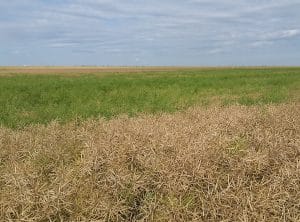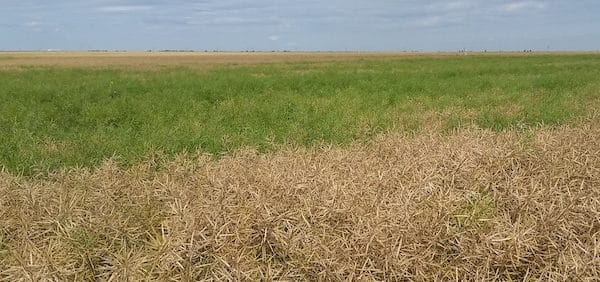Swath timing becomes more difficult in crops with plants at multiple stages of growth. For example, if some plants are at 60% seed colour change (SCC) on the main stem and other plants are still flowering, growers may want to hold off on swathing. Or if plants are large with many secondary stems, the main stem may be at 60% SCC, but seeds in side branches are still mushy and green. These seeds would wither up and amount to nothing if the crop is swathed at 60% SCC on the main stem.

Here are some tips to help with the swath decision on these fields:
Check the whole field. If half the plants are ready and half are just beginning seed colour change, growers may want to hold off on swathing. By waiting 3 or 4 days, there is minimal risk for riper parts of the field and a huge potential benefit for later parts. If late plants make up a small percentage, you may want to ignore them and get started.
Consider dividing the field. If the field has distinct late and early parts, the two parts could be swathed at different times. When assessing stage for swathing, ignore plants that are prematurely ripened due to diseases like sclerotinia, blackleg and clubroot. Later areas, such as those still flowering due to flooding followed by regrowth, sterile plants (usually a small percentage that look worse than they are) or uneven germination, could be swathed separately or not. If the flowering areas are defined patches such as you might expect to see from flooding or uneven germination you could cut around them and comeback for them at a later date. If patches are small and make up a small percent of the overall yield then this strategy becomes less useful. If the flowering plants are extremely late they may not produce seed, or may elevate the green seed count in sample. Swathing these patches before they set seed will limit yield, but may preserve the sample quality.
There is no “perfect” time to swath uneven crops. Choose based on the best time for the majority of plants in the field with the least negative impact possible on the rest.
—If these fields represent a week or more of swathing, you may want to get started. If you have better fields with higher yield potential and more consistent staging, deal with optimal timing on those fields first, and leave the 50-50 fields for later.
—Uneven crops could be left for straight combining. While early maturing plants may start to shell out, late maturing plants have more time to mature. This eliminates the need to make the swath timing decision at all. If using pre-harvest glyphosate in this situation, remember that it must applied after the crop it at 30% seed moisture, or less. If a large percentage of plants have not reached this stage, it can result in elevated glyphosate levels in the seed.

